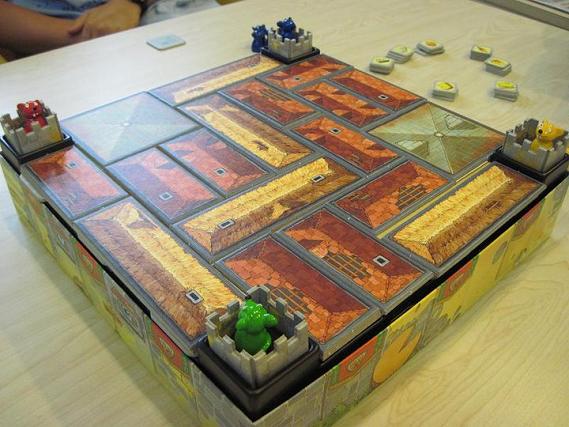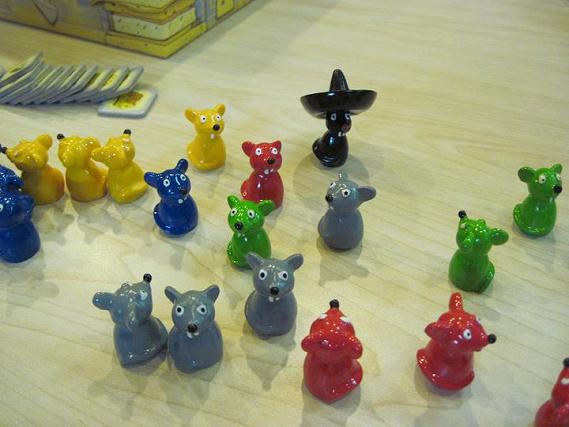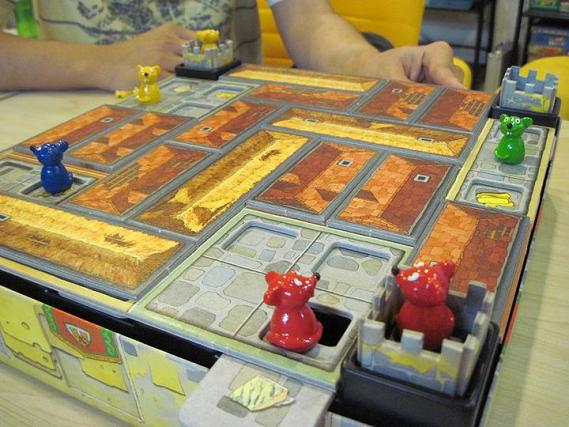
This is yet another kiddie game played at CarcaSean. I’m not sure why Sean buys so many of this type of games. In this case, I was the one who noticed it on his shelf and asked him about it as I wondered what kind of game would be named after a French cheese. After that, I guess he just had to have us play it the following week. I actually messed up on the trivia front as I told him that the cheese was called Chateau Roquefort, when in fact the blue cheese is simply known as Roquefort. Then again, I think the game is wrong too as the name, more properly written as Chateau de Roquefort, refers more to the wine produced there.
Nevertheless, this is a cheese-themed game and each player controls a team of four mice who, predictably enough, want nothing more than to steal the cheese hidden inside the castle. As it turns out, stealing the cheese is quite simple. You simply need to have two of your mice stand on spaces with the same cheese picture on it at the same time to get a tile representing that cheese. The first player who gets four different cheeses this way wins the game. The game also ends when one player is down to only one mouse and therefore can no longer get any cheese.
As these rules imply, moving your mice to the cheeses and standing on them is straightforward, but this is complicated by a number of factors:
- The cheese is hidden underneath the roof tiles and if no mouse is standing on that section, the roof tile is placed back on top of the cheese.
- About half of the rows and columns are composed of movable tiles and the cheese can appear only on these sections of the board. This means that the cheese will move around the board over the course of the game. The game starts with one extra blank tile which players can use to nudge a row of tiles in one direction, so that the tile at the end falls out.
- Three of these movable tiles have a hole in them. So when another moves a row of tiles and causes one these holes to appear underneath a mouse, the poor thing falls into the box and is lost forever. Standing on the immovable tiles is always safe.

During his turn, each player has a total of four actions to perform and the options available are: have a mouse of your color pop out on one of the towers, uncover a roof tile, move one space on the board and most importantly of all, move a row of tiles. The player may spend his four actions on any combination of these options except for the last one, which may only be taken once a turn. Naturally, only one mouse can occupy a space at a time and you can’t run across the covered roof tiles. You must uncover them to move across the area underneath.
So if you’ve been following me so far, this means that whenever a player uncovers a roof tile, everyone is furiously trying to memorize what’s underneath while it’s still exposed. But since the holes and cheeses move around, this is more complicated than you’d think and finding two of the same cheese pictures in locations that are accessible to your mice becomes quite a feat, especially when you’re trying to avoid the holes. In fact, as we played this with four players, we realized that it’s almost impossible to be invulnerable to the holes if you stop on any movable tile as the three other players can cooperate to move the tiles in the right direction until the hole appears underneath your poor mouse.
I ended up winning this particular game as Sean seemed more intent on sending mice tumbling to their doom than trying to score. Shan was the one who pointed out to me at a key point that instead of moving my mouse to a cheese picture, I could manipulate the row of tiles to move the cheese towards my mouse. We also discovered that what tile falls out after the row it’s on is pushed is quite important. If it’s a cheese tile, the next player can reintroduce it to any point along the edge of the board. If it’s a hole tile, the next player can instantly kill any mouse along the edge on a movable row.

All this results in a game that is deceptively deep despite its tilt towards kids and the simple rules. It is a memorization game however, which is not something that I enjoy very much. Combined with how much the position of the cheese tiles can change in the time it takes to get to your next turn, I found it almost maddening to try to seriously work out where everything is. Instead, I just chose a pair that I thought I’d have a good chance of grabbing and concentrated on that. Someone with a very good memory and a good mind for working out spatial transformations would easily sweep up the cheese I think.
Overall, I find Chateau Roquefort to be the best of the kiddie games I’ve played so far. The components are marvelous as well. While I initially suspected that moving the tiles would inevitably involve some jiggling around to get them lined up properly, it worked very smoothly in practice. Sean tells me however that storing the components is a big problem and I see that it’s a recurrent subject that comes up on BGG as well. I’m not sure how well it would work with actual kids though, seeing as there’s no randomness at all and everything is skill and memory based. Unless the adults are deliberately playing to lose, I think kids are going to have a frustrating time with this one.
Leave a Reply